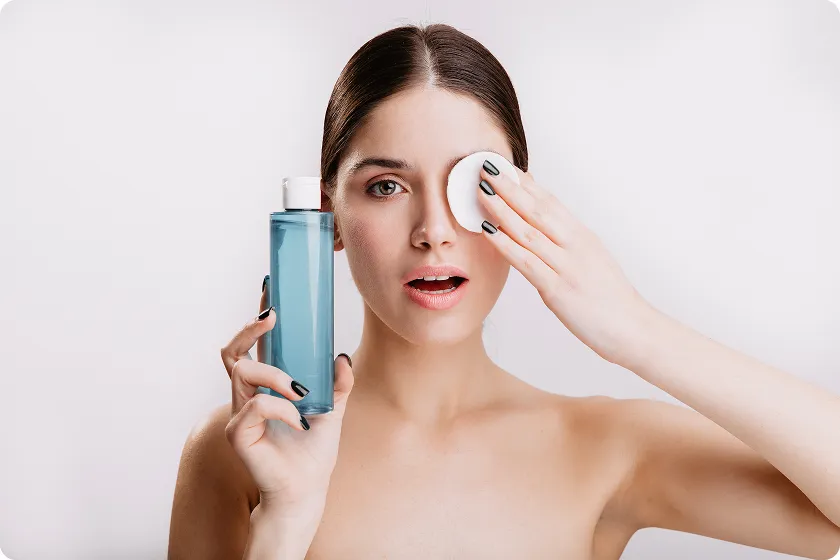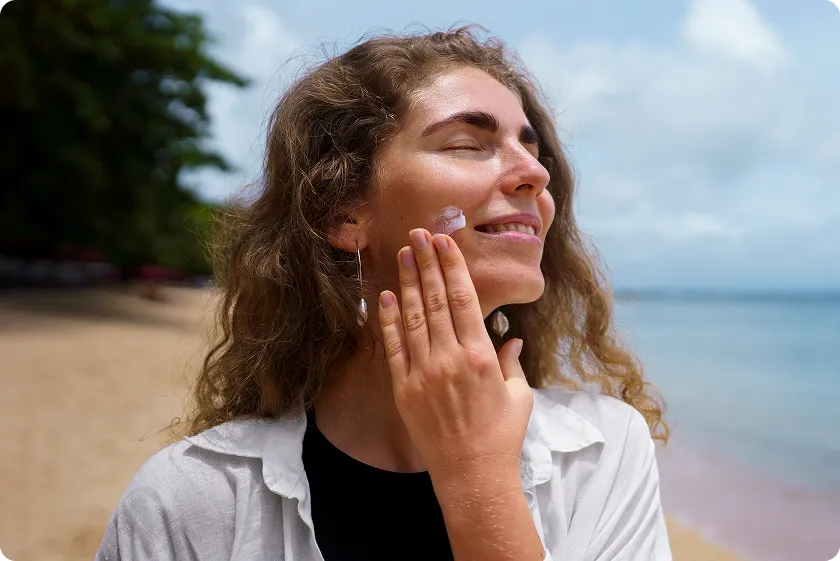Introduction
You understand the difficulty of controlling oily skin if you have ever glanced in the mirror at noon and seen a glossy T-zone looking back. A good oily skin care regimen focuses on maintaining a healthy skin barrier, regulating excess sebum, and balancing moisture rather than removing natural oils.

Many people mistakenly believe oily skin doesn’t need moisturizer or that harsh cleansers help reduce shine. In truth, these habits can backfire, leading to breakouts and dehydration. A smart, dermatologist-recommended routine focuses on gentle cleansing, lightweight hydration, and consistent protection.
In this guide, you’ll discover nine science-backed, practical tips to help you build a customized skin care regimen for oily skin that works—without drying or irritating your skin. Whether you’re new to skincare or refining your daily steps, this article offers expert insights, product tips, and nutrition advice to support clear, balanced, and radiant skin.
1. Understand Your Skin Type
Before building a routine, it’s essential to know whether your skin is truly oily, combination, or dehydrated. Oily skin produces excess sebum—your skin’s natural oil—especially around the forehead, nose, and chin.

Common signs include:
- A greasy shine by midday
- Frequent clogged pores or blackheads
- Makeup sliding off easily
- Fewer visible fine lines
If your cheeks feel dry while your T-zone is oily, you may have combination skin characteristics. Understanding this helps you choose targeted products—like a non-comedogenic moisturizer that hydrates without clogging pores.
Why Balance Matters
Over-cleansing or skipping moisturizer can confuse your skin into producing even more oil. Instead, aim for a routine that keeps the skin barrier healthy using hydrating ingredients like ceramides and hyaluronic acid.
2. Cleanse Gently but Effectively
The first step in any oily skin care regimen is cleansing. Excess oil, debris, and germs must be eliminated without depleting your skin’s natural moisture content.

Choose the Right Cleanser
Look for a dermatologist-recommended cleanser that’s gel-based or foaming, labeled non-comedogenic and sulfate-free.
Ideal ingredients include:
- Salicylic acid – unclogs pores and reduces oil
- Niacinamide – calms redness and regulates sebum
- Green tea extract – offers antioxidants and anti-inflammatory benefits
Avoid bar soaps or harsh alcohol-based formulas—they can cause irritation and overproduction of oil.
How to Cleanse Correctly
- Wash in the morning and the evening twice a day.
- To avoid dehydration, use lukewarm water rather than boiling water.
- For 30 to 60 seconds, massage lightly in circular strokes.
- Double cleaning might be beneficial if you apply sunscreen or makeup. Your typical foamy cleanser should come after a mild oil cleanser (yes, oil can dissolve oil!).
3. Use a Balancing Toner
Toners restore your skin’s pH balance and prepare it for moisturizer. For oily or combination skin, a balancing toner can reduce shine without irritation.

Look for Soothing Ingredients
- Witch hazel or niacinamide for oil control
- Aloe vera for calming effects
- Glycerin for hydration
Avoid toners with high alcohol content. These can damage your skin barrier and trigger excess oil production.
Application Tip
Use a cotton pad or your hands to apply toner after cleaning. To promote skin barrier repair and improve the absorption of your subsequent products, gently pat it into your skin rather than rubbing it in.
4. Hydrate Without Heaviness
Even oily skin needs hydration. Dehydrated skin overcompensates by producing more oil, leading to clogged pores and breakouts. Choose a lightweight, non-comedogenic moisturizer that hydrates while maintaining balance.

Choose a lightweight, non-comedogenic moisturizer that hydrates while maintaining balance.
| Ingredient | Benefit |
| Hyaluronic Acid | Provides deep hydration without greasiness |
| Ceramides | Fortify the skin barrier and retain hydration. |
| Glycerin | Attracts and retains water in the skin |
| Niacinamide | Reduces redness and controls oil |
What Ingredients to Look For
When choosing the best skin moisturizer for dry skin, select one formulated with hyaluronic acid or ceramides—these also benefit oily or combination skin when used in gel or lotion form.
5. Exfoliate Wisely for Clearer Skin
Exfoliating eliminates dead skin cells, clears out pores, and improves skin texture—but excessive exfoliation can irritate the skin and exacerbate oiliness.

Best Exfoliants for Oily Skin
Opt for chemical exfoliants like BHA (salicylic acid) or AHA (glycolic acid) instead of harsh physical scrubs. These ingredients penetrate pores, dissolve sebum, and prevent acne.
How Often Should You Exfoliate?
- Two to three times per week is usually enough. For sensitive or acne-prone skin, start once a week and gradually increase.
- Look for a gentle exfoliant for sensitive skin that balances oil control with hydration.
6. Prioritize Sun Protection for Sensitive Skin
One of the most frequent skincare errors is not using sunscreen. Sun protection is necessary even for oily skin in order to avoid inflammation, discoloration, and premature aging.

Why Is Sun Protection Important for Sensitive Skin?
UV exposure triggers inflammation, damages collagen, and weakens your skin barrier. Using daily SPF helps prevent these effects and protects against skin cancer.
Choosing the Right Sunscreen
Look for:
- Oil-free or matte-finish formulas
- Mineral (zinc oxide or titanium dioxide) filters for sensitive skin
- SPF 30 or higher
Reapply every two hours, especially if you’re outdoors or sweating. Sunscreen is a must-have in any skin care regimen for oily skin.
7. Nourish with the Right Ingredients
Ingredients matter. The right actives can transform oily skin from greasy to glowing.

Power Ingredients for Oily Skin
- Niacinamide – reduces oil and minimizes pores
- Zinc PCA – balances sebum
- Retinol – promotes cell turnover
- Tea tree oil – natural antibacterial properties
Avoid heavy oils like coconut oil. Instead, try natural plant oils for skin such as jojoba or squalane—they mimic natural sebum and help regulate oil production.
8. Support Healthy Skin from Within
Your diet significantly influences the state of your skin. For instance, foods that enhance hydration and regulate oil production are two key examples.

What Foods Support Healthy Skin?
- Omega-3 fatty acids (salmon, walnuts) – reduce inflammation
- Vitamin A & C-rich foods (carrots, citrus) – promote skin repair
- Water-rich foods (cucumber, melon) – improve hydration
Can specific meals increase the moisture of your skin? If you’re wondering, in particular, those high in healthful fats and antioxidants. Maintaining the equilibrium of your skin is another benefit of being hydrated by drinking lots of water.
9. Know When to Adjust Your Routine
Even the best routine needs tweaks over time. Environmental changes, stress, or hormonal fluctuations can affect your skin’s oil levels.
What Are the Signs I Need to Change My Skin Care Routine?
If you notice more breakouts, dryness, or dullness, your products might be too harsh—or not hydrating enough. Adjust your cleanser or moisturizer accordingly.
If you’re uncertain, consult a dermatologist for concerns related to your skin. They can suggest therapies like chemical peels or prescribed creams customized to your individual skin type.
Simplify When Needed
If you’re overwhelmed by steps, focus on the essentials:
Cleanse → Moisturize → Sunscreen
That’s how you can simplify your daily skin care routine effectively without sacrificing results.
FAQs
1. How do I build a skin care routine for dry skin if I also have oily areas?
Focus on gentle hydration and balance. Use a gel-based cleanser for oily zones and a light lotion on dry areas. Choose products with ceramides and hyaluronic acid hydration to support both needs.
2. What are the best steps in a skin care routine for oily skin?
The key steps are: cleanse, tone, moisturize, and protect with SPF. Add exfoliation and serums weekly to target oil control and improve texture.
3. Why is sun protection important for sensitive skin?
Because UV rays cause irritation and accelerate aging. Using sun protection for sensitive skin keeps your complexion calm, youthful, and protected.
4. What components should I search for in an oily or dry skin moisturizer?
Check for glycerin, niacinamide, ceramides, and hyaluronic acid. These are perfect for both dry and oily skin types since they deeply moisturize without blocking pores.
5. Which natural skin care products are appropriate for skin that is sensitive?
Aloe vera, green tea, or squalane are great ingredients in mild, sensitive skin care products. Alcohol and artificial scents should be avoided.
6. For skin care concerns, when should I consult a dermatologist?
See a dermatologist if you have ongoing acne, discomfort, or changes that don’t seem to be related to your skin. They can evaluate your skin barrier repair regimen and provide a personalized strategy.
Conclusion
Creating the best skin care routine for oily skin is about balance—not battling your natural oils. By choosing non-comedogenic, lightweight, and hydrating products, you can achieve a shine-free yet healthy glow.
Remember to cleanse gently, hydrate wisely, and protect daily with sunscreen. Eat nourishing foods, listen to your skin’s signals, and don’t hesitate to consult a dermatologist when needed.
A consistent, mindful skin care regimen for oily skin helps you feel confident in your natural skin—radiant, balanced, and beautifully yours.
Developing a skincare plan takes time, but every step brings you closer to lasting results. Experiment with products that support your skin barrier repair routine, including gentle exfoliation, and stay consistent. Small daily efforts can transform how your skin looks and feels, improving both your confidence and long-term skin health. Whether you struggle with excess shine, dryness, or sensitivity, remember that balance is key. Choose products rich in ceramides and hyaluronic acid hydration, follow a steady routine, and protect your skin from sun damage. With patience and care, your journey toward a healthier, glowing complexion starts today.
Internal Links
- Sleep Hygiene Checklist: 8 Complete Ways to Increase Rest
- Success Starts Here: 2025 Healthy Morning Routine
- Daily Exercise Routine: 7 Full Body Workouts at Home



